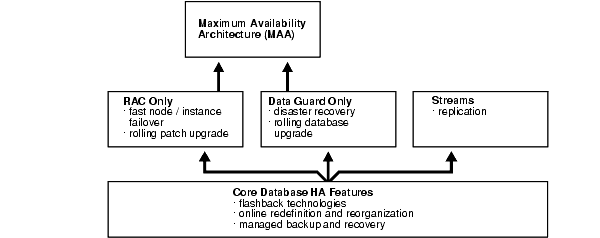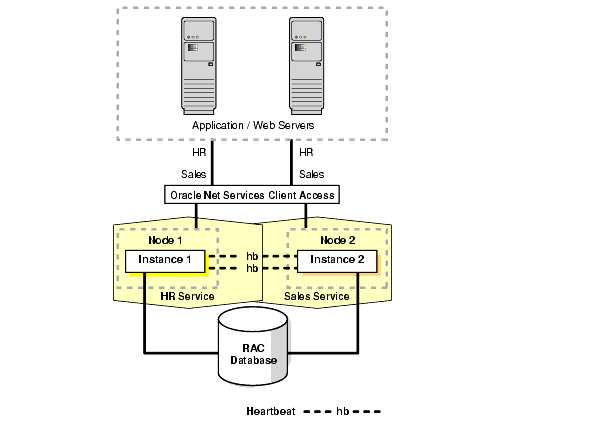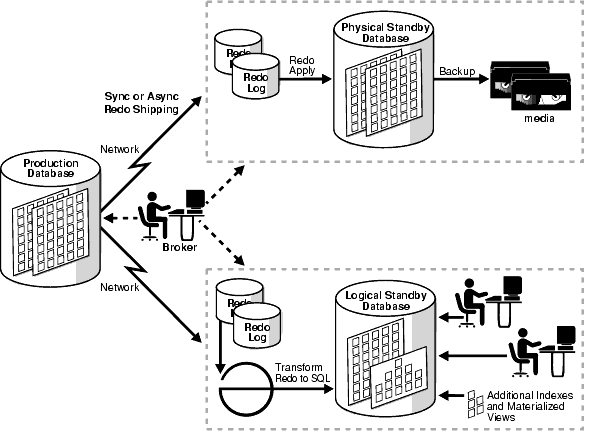| Oracle® High Availability Architecture and Best Practices 10g Release 1 (10.1) Part Number B10726-01 |
|
|
View PDF |
| Oracle® High Availability Architecture and Best Practices 10g Release 1 (10.1) Part Number B10726-01 |
|
|
View PDF |
This chapter describes high availability architectures in an Oracle environment. It includes the following sections:
This section defines the top five database architectures that address various high availability business needs. The architectures described are:
Oracle provides a wide array of HA architectural solutions. The "Database only" architecture is not highly available, but it contains many availability features and assets that are used by all other architectures. The "Database only" architecture is the starting point for most customers. "RAC only", "Data Guard only", and Streams architectures provide additional HA capabilities in addition to the "Database only" capabilities. MAA incorporates both RAC and Data Guard advantages and represents the architecture with maximum availability. Figure 4-1 illustrates the hierarchy of the different HA architectures.

Text description of the illustration maxav032.gif
The following sections describe each architecture and their advantages in more detail:
Oracle provides HA features that can be used in any of the database architectures. These features make the standalone database on a single machine attractive and available. These features are described in Table 4-1. Chapter 9, "Recovering from Outages" describes when to use these features to resolve different outages, while Chapter 10, "Detailed Recovery Steps" contains details about how to use the features to recover.
"RAC only" architecture uses Real Application Clusters and is an inherently high availability system.The clusters that are typical of RAC environments can provide continuous service for both planned and unplanned outages. RAC build higher levels of availability on top of the standard Oracle features. All single instance HA features, such as flashback technologies and online reorganization, apply to RAC as well.
In addition to the standard Oracle features, RAC exploits the redundancy that is provided by clustering to deliver availability with n - 1 node failures in an n-node cluster. All users have access to all as long as there is one available node in the cluster.
This architecture provides the following benefits:
Figure 4-2 shows "RAC only" architecture.

Text description of the illustration maxav015.gif
Data Guard provides a rich set of HA solutions and addresses the requirements of the business community for a disaster recovery solution. Data Guard supports Data Guard Redo Apply and Data Guard SQL Apply technologies to enable two distinct kinds of standby databases: physical standby database and logical standby database.
Physical standby databases have provided HA solutions to thousands of applications since Oracle version 6. The introduction of Oracle Data Guard in Oracle8i and further enhancements in the Oracle9i and Oracle Database 10g releases have provided a simple and sophisticated HA suite. Data Guard physical standby architectures are the most efficient and simplest standby database environments. Logical standby databases, introduced in Oracle9i, enable recovery of transactions while permitting read and write operations to occur simultaneously in the same database. Logical standby databases require additional processing, but for some applications, they can be a very suitable HA solution or can complement other solutions. For some customers, both physical and logical standby databases can be used as part of an HA solution, which is recommended in MAA. The physical standby database becomes the initial switchover and failover target, while the logical standby database is used for reporting, queries, and additional processing to relieve the load on the production database. The logical standby database can also be targeted for switchovers, failovers, and rolling database upgrades.
Physical standby databases provide these advantages:
In addition to disaster recovery and data protection, logical standby databases provide the following benefits:
A recommended configuration for many cases includes both physical and logical standby databases. They can reside on the same database machine or cluster, but they should be remote from the production database. The physical standby database can be reserved for failovers in case of disaster, and the logical standby database can continue to be used for reporting. The physical standby database provides a faster apply technology because redo logs do not have to be converted to SQL.
Figure 4-3 shows the production database at the primary site and the standby databases at the secondary site.

Text description of the illustration maxav020.gif
See Also:
|
RAC and Data Guard provide the basis of the database MAA solution. MAA provides the most comprehensive architecture for reducing downtime for scheduled outages and preventing, detecting, and recovering from unscheduled outages. The recommended MAA has two identical sites. The primary site contains the RAC database, and the secondary site contains both a physical standby database and a logical standby database on RAC.
Identical site configuration is recommended to ensure that performance is not sacrificed after a failover or switchover. Symmetric sites also enable processes and procedures to be kept the same between sites, making operational tasks easier to maintain and execute.
Figure 4-4 provides an overview of the architecture.

Text description of the illustration maxav004.gif
Streams is meant for information sharing and distribution. It can also provide an efficient and highly available architecture.
Streams provides granularity and control over what is replicated and how it is replicated. It supports bidirectional replication, data transformations, subsetting, custom apply functions, and heterogeneous platforms. It also gives users complete control over the routing of change records from the primary database to a replica database. This enables users to build hub and spoke network configurations that can support hundreds of replica databases.
Streams should be evaluated if one or more of the following conditions are true:
For disaster recovery, Data Guard is Oracle's recommended disaster recovery solution.
Figure 4-5 shows Streams architecture.

Text description of the illustration maxav019.gif
This section summarizes the advantages of the HA architectures discusses in this chapter and then provides guidelines for you to choose the correct HA architecture for your business.
Table 4-2 summarizes the advantages of the five basic HA architectures described in this chapter.
| Database HA Architecture | Advantages |
|---|---|
|
Production database on a standalone machine |
Reduced downtime for application and Oracle upgrades Flashback capabilities to protect from user errors, and logical corruptions Online redefinition and reconfiguration to minimize scheduled downtime Backup and recovery capabilities Fast and efficient object re-creation features Simple and integrated management framework with Oracle Enterprise Manager Note: All of these advantages are available for the other architectures described in this table, but they will not be repeated. |
|
RAC production database |
Transparent to the application See Also: ""RAC Only" Architecture" |
|
Production database (not RAC) on the primary site Standby databases on the secondary or disaster recovery site |
Transparent to the application See Also: ""Data Guard Only" Architecture" |
|
RAC production database on the primary site Standby databases on the secondary or disaster recovery site |
Transparent to the application See Also: ""RAC Only" Architecture" and ""Data Guard Only" Architecture" |
|
Primary site: Production database Secondary or additional sites: Database replicated using Streams |
Full active/active configuration Database configurations can be heterogeneous platforms See Also: "Streams Architecture" |
"RAC only" and "Data Guard only" are the most common Oracle HA architectures, and each provides very significant HA advantages. MAA provides the most redundant and robust HA architecture. It prevents, detects, and recovers from different outages within a small mean time to recover (MTTR), as well as preventing or minimizing downtime for maintenance. The Streams architecture is an alternative high availability solution, but it requires more customization and may not be as transparent to the application.
You must consider your service level agreements in your decision about which HA architecture to implement. To decide whether to implement an Oracle HA architecture that includes RAC or Data Guard, consider the following questions about your service level agreements:
Table 4-3 shows the recommended architecture for each set of answers to the questions.
If your business requires any of the following, then you should evaluate Oracle Streams in more depth:
There are other Oracle and non-Oracle HA solutions. This section focuses on the most common variants. Table 4-4 describes each alternative HA proposal, its disadvantages and the recommended Oracle HA architecture.